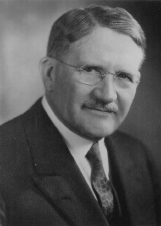Ezra Scattergood Biography
 |
Ezra Scattergood, the father of municipal power in Los Angeles, was a pioneer who devoted his life to bringing ample supplies of electric energy to the city of Los Angeles. |
Ezra Scattergood (1871-1947) |
Commitment to Public Service
Born on a New Jersey farm in 1871, Scattergood decided early to devote his life to public service, believing that “satisfaction in life is proportional to one’s usefulness, and not money accumulation.”
After graduating with a Bachelor of Science degree from the Electrical Department at Rutgers University, he earned his Master’s in mechanical engineering from Cornell University. He then spent several years as a professor of electricity and experimental engineering at the Georgia School of Technology.
During this period, Scattergood’s personal life also grew. He married Lulie Chilton in 1901 and became a father several years later when their only child, Elizabeth, was born.
He moved to Los Angeles in 1902, spending several years as an electrical engineer. Four years later, he entered public service when the city retained him as a consulting engineer to plan and develop hydroelectric power for the construction of the Los Angeles Owens River Aqueduct. After studying plans for the aqueduct, Scattergood decided to place power plants at the end of a tunnel under Elizabeth Lake. The electric revenues from the plants helped pay for the tunnel and reduced construction costs of the aqueduct.
As he worked on the aqueduct plants, Scattergood came to believe that the city’s destiny rested upon an abundant supply of low-cost water and electricity. And he believed that the municipal distribution of these resources was tremendously important for the city’s growth and prosperity.
“Water and hydroelectric power are fundamental and vital necessities in our Southwestern country, with its slight rainfall and both limited and costly fuel supply,” Scattergood said. “These utilities are the basis and measure of our progress. They are locked up in our natural streams and to possess the key is to control the destiny of our people.”
Scattergood was in a position to implement these ideas in 1909, when he was appointed the chief electrical engineer of the Bureau of Los Angeles Aqueduct Power. Two years later, voters approved a charter amendment that established a municipal power system called the Bureau of Power and Light, and Scattergood was again named chief electrical engineer.
Under his supervision, hydroelectric plants were built along the Los Angeles Owens River Aqueduct. The success of these plants enabled the Bureau to buy out most of the private power companies in the city. The largest acquisition came in 1922, when the Bureau purchased the Southern California Edison’s distribution system in Los Angeles.
In Search of Low-Cost Power
Scattergood realized the city needed more electricity to sustain its rapidly growing population. He pointed out that inexpensive power would create an opportunity for thousands of workers migrating to the area in increasing numbers. In 1920, he pushed for a bill authorizing the construction of the Boulder Canyon Project (Hoover Dam). Despite attempts to discredit the project, Scattergood helped convince Congress in 1928 to pass the legislation and allow construction of the dam and a hydroelectric power plant.
He also negotiated a $23 million loan from the government to finance construction of the 266-mile Boulder Transmission Line, a giant undertaking that would bring electricity over deserts and mountains to Los Angeles. In 1936, the Boulder lines were completed and became the highest voltage long-distance transmission system in the world at that time.
In 1937, the Bureau of Power and Light consolidated with the Bureau of Water Works and Supply and became the Department of Water and Power. The Department became the sole distributor of power in the city after purchasing the electrical system of the Los Angeles Gas and Electric Corporation.
During the next few years, Los Angeles exploded into a booming metropolis, and under Scattergood’s leadership, the DWP kept pace with rapid changes by constructing new facilities and seeking new energy supplies. Meanwhile, Scattergood continued to push for low-cost power to support industrial expansion. Low rates became the backbone of Los Angeles’ industrial development and spurred even more growth in the city.
Scattergood remained at the helm of the Power System for 31 years. He was appointed to the National Power Policy Committee on Preparedness by President Franklin Delano Roosevelt and continued as chief electrical engineer until 1940. After retiring, he remained busy as an advisory engineer to the DWP and one of the founders and president of the American Public Power Association.
When Scattergood died in 1947, he left a rich legacy. Under his direction, the Power System grew from an organization with one employee into the largest municipal utility of its kind in the world. His quest to bring low-cost, abundant energy to Los Angeles helped turn the city into the premier metropolis it is today.
As Mayor Fletcher Bowron once said: “It is difficult to overestimate the tremendous contribution (Scattergood) has made to Los Angeles and for the benefit of people of this community.” *
Reference
< Back
Menu
- Home
- Mission
- Museum
- Major Efforts
- Recent Newsletters
- Historical Op Ed Pieces
- Board Officers and Directors
- Mulholland/McCarthy Service Awards
- Positions on Owens Valley and the City of Los Angeles Issues
- Legislative Positions on
Water Issues
- Legislative Positions on
Energy Issues
- Membership
- Contact Us
- Search Index